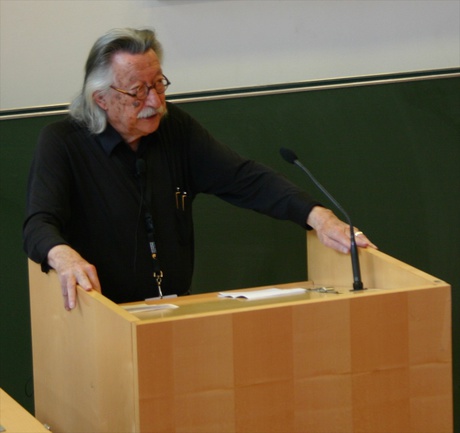Tag: art
Was ist die Aufgabe des Künstlers?
Da kommt Ionesco herein: „Alles ist sagbar in Worten. Nur nicht die lebende Wahrheit.“ […]
Was ist die Aufgabe des Künstlers? Es gibt Sachen…, es gibt viel Sachen, vielleicht sind es die wichtigsten Sachen, die wir wissen, wir alle hier, die wir nicht sagen können. Die Sprache reicht nicht aus. Und die Aufgabe des Künstlers ist die Grenzen der Sprache ja zu, zu zersprengen, wenn möglich; aber es ist nicht möglich.
Besonders der Dichter ist gefährdet. Dichter ermorden sich selbst – aus Frustration sozusagen. Aber die Aufgabe des Künstlers ist irgend einen Weg zu finden, die Aussagekraft des Menschen zu vergrößern. Dieser Weg kann Malerei sein, es kann Gedicht sein. Es kann Musik sein. Es kann der Roman sein usw. Ich denke hier an Ulysses, zum Beispiel der Roman. Ein Tag(!) in einem Leben. Das ist so’n dickes Buch.Sie spüren eine Hand auf ihrer Schulter. Was passiert. Und jetzt versuchen Sie es aufuschreiben. Sie kommen nach Hause und hatten eine Erfahrung: die Hand auf der Schulter. Was auch immer der Kontext war.… Es könnte… Also ich sag nichts weiter darüber. Aber es stellt sich aus, wenn sie es völlig beschreiben wollten, dann würde es den Rest ihres Lebens dauern. Sie können es nicht. Sie wissen, aber sie können es nicht sagen.
Da ist die Geschichte von Picasso. Da steht ein Mann im Museum. Es sieht sich an Guernica. Picasso läuft vorbei. Der Mann, „ach, Meister, wie ich das Bildnis liebe!“ Und schwärmt und schwärmt. Und sagt, „aber sagen sie mir, was bedeutet es?“ Und Picasso antwortet, „wenn ich ihnen das sagen könne, würde ich ein Schriftsteller sein. Aber ich bin ein Maler.
Follow my Heart
 |
| Ungrateful Heart by Francesco-Fusco |
My heart belongs to me.
White on White
Brian Eno and Danny Hillis talk about their white period.
Here is my twist on the subject:

It dawned on me that 256 times 256 pixel at 8 bit gif color range all set to white – represent the total random access memory of my first computer, the Apple //e, with 64KB RAM – stunning!
You can also view it on deviantART
What about this white on white?

It is the Mandelbrot set rendered by frax at 2048 x 1536 pixels with the set set to white. It is also available on deviantART.
[Update] Albertina 2016: White on White

Malevich at Albertina, Vienna, 2016

